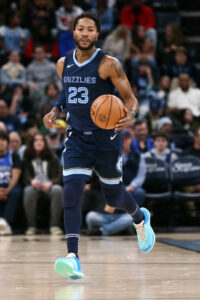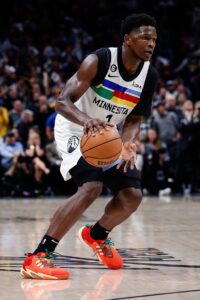Derrick Rose‘s name doesn’t technically show up at all in the NBA’s Collective Bargaining Agreement. However, like Gilbert Arenas, the veteran NBA guard has become an informal namesake of one of the CBA’s rules.
 The Rose rule allows a player who is finishing his rookie scale contract to sign a maximum-salary contract that exceeds the typical limit for a player with fewer than seven years of NBA experience. The rule, which was created after Rose won a Most Valuable Player award while playing on his rookie contract, allows young stars to qualify for a maximum salary worth 30% of the salary cap instead of 25%.
The Rose rule allows a player who is finishing his rookie scale contract to sign a maximum-salary contract that exceeds the typical limit for a player with fewer than seven years of NBA experience. The rule, which was created after Rose won a Most Valuable Player award while playing on his rookie contract, allows young stars to qualify for a maximum salary worth 30% of the salary cap instead of 25%.
Although we colloquially refer to this rule as the Rose rule, it’s technically known in the CBA as the “higher max criteria” for “fifth year eligible” players, since a player has to meet certain performance benchmarks to qualify for the higher maximum salary in his fifth NBA season. A player becomes eligible for the 30% max entering his fifth season when at least one of the following is true:
- The player was named to an All-NBA team in the most recent season, or in two of the past three seasons.
- The player was named Defensive Player of the Year in the most recent season, or in two of the past three seasons.
- The player was named Most Valuable Player in any of the past three seasons.
A player signing a rookie scale extension can receive the higher Rose rule max as long as his extension covers at least four new years. A player signing a free agent contract can also be eligible for the Rose rule max if he’s coming off his four-year rookie contract — or if he’s a former second-round pick or undrafted free agent with four years of experience, and he’s re-signing with his current team.
This latter scenario almost never arises, since it’s extremely rare for a player who wasn’t drafted in the first round to develop into an All-NBA player within four years. There are rare scenarios in which it might happen — Nikola Jokic, for instance, was a second-round pick who made the All-NBA team in his fourth season. But he had already signed a second contract by that point, having re-upped with the Nuggets as a restricted free agent following his third season.
Of course, just because a player is eligible for a Rose rule extension, that doesn’t mean a team has to offer a starting salary worth the full 30% max. That’s still a matter of negotiation between the player and team, and a starting salary between 25-30% is possible.
Teams and players who agree to a rookie scale extension can also negotiate conditional maximum starting salaries that hinge on the player’s performance in his fourth season, before his extension begins.
For example, a team and player could agree to the following terms:
- The player’s starting salary will be worth 25% of the cap if he doesn’t make an All-NBA Team in his fourth season.
- The player’s starting salary will be worth 27% of the cap if he’s named to the All-NBA Third Team.
- The player’s starting salary will be worth 28% of the cap if he’s named to the All-NBA Second Team.
- The player’s starting salary will be worth 30% of the cap if he’s named to the All-NBA First Team.
Several players have agreed to this form of Rose rule extension since the rule was implemented in 2017. Devin Booker, Ben Simmons, and Pascal Siakam were among the players whose starting salaries on their rookie scale contracts could have ranged from between 27-30% depending on which All-NBA team they made.
Siakam was voted to the All-NBA Second Team the spring before his rookie scale extension went into effect, securing a starting salary worth 28% of the cap, based on the terms of his Rose rule deal. Simmons’ contract also began at 28% of the cap after he made an All-NBA Third Team that same year. Booker missed out on All-NBA honors ahead of his fourth season, however, so he received a standard 25% max deal.
 In recent years, the significant majority of rookie scale extensions that include Rose rule language have been more of a yes or no proposition — a player qualifies for the 30% max with an All-NBA spot, regardless of which team he makes.
In recent years, the significant majority of rookie scale extensions that include Rose rule language have been more of a yes or no proposition — a player qualifies for the 30% max with an All-NBA spot, regardless of which team he makes.
That’s reportedly the case for Anthony Edwards, Tyrese Haliburton, and LaMelo Ball, who signed maximum-salary rookie scale extensions this past offseason and would receive a bump to the 30% max by making an All-NBA team in 2024.
While a player can, in some cases, meet the Rose rule performance criteria after he signs his contract, he must meet the criteria before the contract begins. So if Edwards were to miss out on an All-NBA spot in 2024, then earned one in 2025, it would be too late for him to qualify for a Rose rule deal — his maximum-salary contract would start at 25% of the cap in 2024/25 and increase by 8% annually from there.
It’s worth noting that NBA’s previous Collective Bargaining Agreement also included the “designated rookie” rule, which was separate from the Rose rule but often applied to Rose rule deals. The designated rookie rule allowed teams to sign players to rookie scale extensions that spanned five new years instead of four. Teams weren’t permitted to carry more than two designated rookies at a time, including no more than one who was acquired via trade.
However, the latest CBA eliminated the designated rookie rule, allowing all rookie scale extensions to cover up to five new years and placing no restrictions on how many of those players those teams are permitted to carry or acquire. The Rose rule is now the only one governing deviations from the norm for rookie scale extensions.
Finally, a player with between seven and nine years of experience can qualify for a maximum salary worth 35% of the cap instead of 30% by meeting similar criteria, but that’s related to the designated veteran rule rather than the Rose rule. We cover that subject in a separate glossary entry.
Note: This is a Hoops Rumors Glossary entry. Our glossary posts will explain specific rules relating to trades, free agency, or other aspects of the NBA’s Collective Bargaining Agreement. Larry Coon’s Salary Cap FAQ was used in the creation of this post.
Earlier variations of this post were published in 2013 and 2018 by Chuck Myron and Luke Adams.
 The Rose rule allows a player who is finishing his rookie scale contract to sign a maximum-salary contract that exceeds the typical limit for a player with fewer than seven years of NBA experience. The rule, which was created after Rose won a Most Valuable Player award while playing on his rookie contract, allows young stars to qualify for a maximum salary worth 30% of the salary cap instead of 25%.
The Rose rule allows a player who is finishing his rookie scale contract to sign a maximum-salary contract that exceeds the typical limit for a player with fewer than seven years of NBA experience. The rule, which was created after Rose won a Most Valuable Player award while playing on his rookie contract, allows young stars to qualify for a maximum salary worth 30% of the salary cap instead of 25%. In recent years, the significant majority of rookie scale extensions that include Rose rule language have been more of a yes or no proposition — a player qualifies for the 30% max with an All-NBA spot, regardless of which team he makes.
In recent years, the significant majority of rookie scale extensions that include Rose rule language have been more of a yes or no proposition — a player qualifies for the 30% max with an All-NBA spot, regardless of which team he makes.